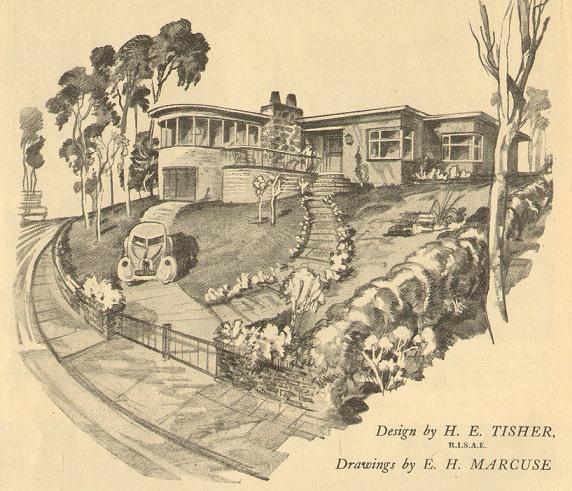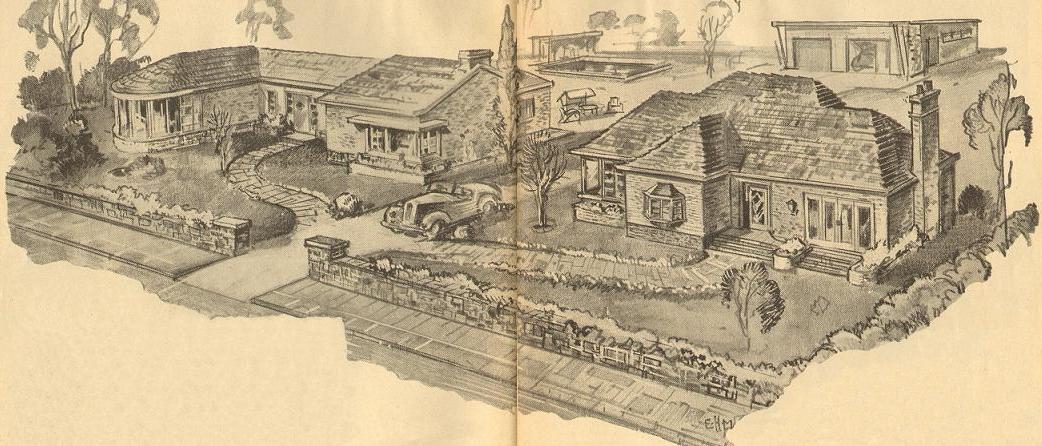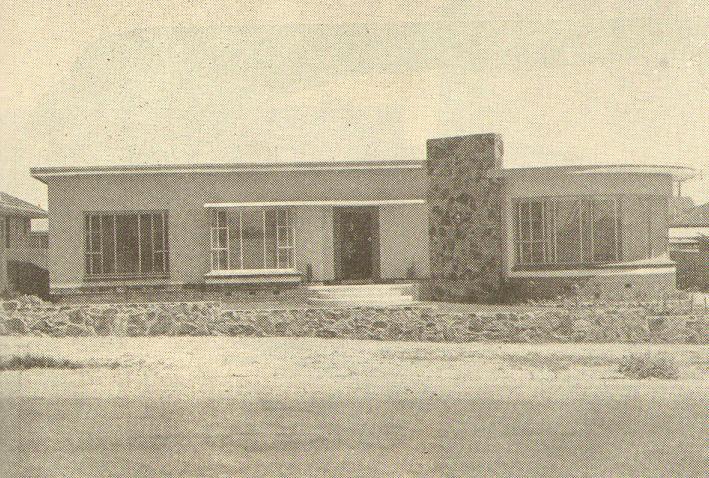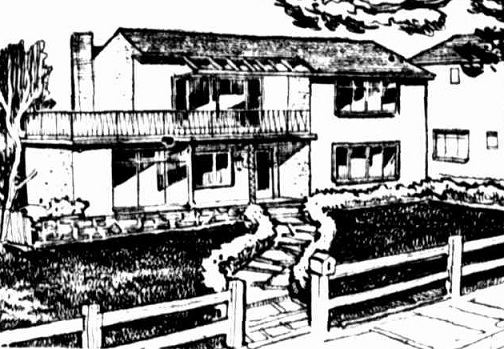Herbert Tichaeur was born on 26 March 1915 in Essen, Germany, and educated at a local high school, where he
completed his University Leaving Certificate in March 1932.
He spent the next two years working for "various building
trades" (including concreting, carpentry, bricklaying and
plastering), which was a requirement for admission into German
architectural schools at that time. He completed the first year
of the diploma course at the Technical High School in Stuttgart before
he was forced to leave, as he put it, "on account of the changed
political situation in Germany". After spending six months in the
office of an architect in Stuttgart, Tichauer moved to Italy, where he
resumed his architectural studies at the Art-Academy in Milan. In
December 1936, he entered the office of Dr Gustavo Pulitzer-Finale
(1887-1967), an architect and industrial designer in Trieste who was
then one of Europe's leading specialists in hotel design and the
fitouts of ocean liners. Tisher spent the next eighteen months in
Pulitzer's employ, during which time, by his own account, he worked on
structural and industrial planning, town planning and naval
architecture, as well as general architectural work.
With the political situation in Europe worsening, Tichauer decided to migrate to Australia. After his arrival in Melbourne in July 1938, an immigration official recommended that he anglicize his surname to Tisher, and also to adopt a middle name; he promptly selected the name Edward, after the former English monarch, Edward VIII. Almost immediately after his arrival, Tisher, he gained a position as chief interior designer for the new Hotel Australia in Collins Street, which was then being designed by Leslie Perrott & Partners, and also enrolled in the diploma course at the Melbourne Technical College. During 1939, Tisher spent six months in the office of A S & R E Eggleston before abandoning his diploma studies and starting up his own practice in early 1940. Over the next two years, Tisher primarily worked as an interior designer, although he still undertook several residential projects, including a house in Toorak for the Turkish consul, Yves Nahama. It was also during this busy this period, on 26 June 1941, that Tisher married Lotte (Lorna) Hertzberg, a fellow German emigre who arrived in Melbourne in March 1939 and was working as a clerk at the Pelaco shirt factory in Richmond.
In 1942, when private commissions began to decrease with the introduction of war-related building restrictions, Tisher closed his office and took a position as a mechanical draftsman for a company engaged in heating and air-conditioning work. In early 1943, he transferred to a similar position with engineers Woodall-Duckham (Australia) Pty Ltd, where he gained experience in large industrial projects. During 1945, Tisher also contributed several articles to the Australian Home Beautiful on the subject of contemporary furniture design.
After the Second World War, Tisher resumed his private practice in Melbourne; during this period, some of his presentation drawings were prepared by another compatriot, Berlin-born Ernest Heinrich Marcuse (1900-1985). By 1946, Tisher was advertising himself in the pages of the Australian Jewish Herald as an "architect and interior designer", despite the fact that he had not yet become registered as an architect in Victoria. Due to somewhat draconian regulations regarding the local recognition of overseas qualifications, Tisher did not in fact become registered until as late as June 1953. By that time, however, his private practice was already thriving with numerous residential commissions, of which many were designed for members of Melbourne's burgeoning post-War Jewish community. It was such connections that, in 1950, brought Tisher a commission from the South Brighton Hebrew Congregation to design what was described on the original working drawings as a "proposed Sunday School and religious meeting place" but was, in fact, the first new synagogue to be erected in Victoria after the Second World War. Towards the end of that decade, Tisher branched out into the design of larger-scale multi-unit dwellings. One of his first of these was the four-storey Toorak Towers, where, in 1958, he transferred his own professional offices from the Collins Street address he had maintained for twenty years. Tisher went on to design Orrong Towers, an eight-storey building that was not only the first high-rise apartment block in the Toorak area, but also the first major building in Melbourne to be erected using the lift-slab technique.
In the early 1970s, Tisher erected an office and showroom for his own use in Hall Street, Hawthorn East, not far from where he resided in Mount Ida Avenue. Registered as an architect for five decades, he reluctantly retired due to illness in 1993, and died five years later.
With the political situation in Europe worsening, Tichauer decided to migrate to Australia. After his arrival in Melbourne in July 1938, an immigration official recommended that he anglicize his surname to Tisher, and also to adopt a middle name; he promptly selected the name Edward, after the former English monarch, Edward VIII. Almost immediately after his arrival, Tisher, he gained a position as chief interior designer for the new Hotel Australia in Collins Street, which was then being designed by Leslie Perrott & Partners, and also enrolled in the diploma course at the Melbourne Technical College. During 1939, Tisher spent six months in the office of A S & R E Eggleston before abandoning his diploma studies and starting up his own practice in early 1940. Over the next two years, Tisher primarily worked as an interior designer, although he still undertook several residential projects, including a house in Toorak for the Turkish consul, Yves Nahama. It was also during this busy this period, on 26 June 1941, that Tisher married Lotte (Lorna) Hertzberg, a fellow German emigre who arrived in Melbourne in March 1939 and was working as a clerk at the Pelaco shirt factory in Richmond.
In 1942, when private commissions began to decrease with the introduction of war-related building restrictions, Tisher closed his office and took a position as a mechanical draftsman for a company engaged in heating and air-conditioning work. In early 1943, he transferred to a similar position with engineers Woodall-Duckham (Australia) Pty Ltd, where he gained experience in large industrial projects. During 1945, Tisher also contributed several articles to the Australian Home Beautiful on the subject of contemporary furniture design.
After the Second World War, Tisher resumed his private practice in Melbourne; during this period, some of his presentation drawings were prepared by another compatriot, Berlin-born Ernest Heinrich Marcuse (1900-1985). By 1946, Tisher was advertising himself in the pages of the Australian Jewish Herald as an "architect and interior designer", despite the fact that he had not yet become registered as an architect in Victoria. Due to somewhat draconian regulations regarding the local recognition of overseas qualifications, Tisher did not in fact become registered until as late as June 1953. By that time, however, his private practice was already thriving with numerous residential commissions, of which many were designed for members of Melbourne's burgeoning post-War Jewish community. It was such connections that, in 1950, brought Tisher a commission from the South Brighton Hebrew Congregation to design what was described on the original working drawings as a "proposed Sunday School and religious meeting place" but was, in fact, the first new synagogue to be erected in Victoria after the Second World War. Towards the end of that decade, Tisher branched out into the design of larger-scale multi-unit dwellings. One of his first of these was the four-storey Toorak Towers, where, in 1958, he transferred his own professional offices from the Collins Street address he had maintained for twenty years. Tisher went on to design Orrong Towers, an eight-storey building that was not only the first high-rise apartment block in the Toorak area, but also the first major building in Melbourne to be erected using the lift-slab technique.
In the early 1970s, Tisher erected an office and showroom for his own use in Hall Street, Hawthorn East, not far from where he resided in Mount Ida Avenue. Registered as an architect for five decades, he reluctantly retired due to illness in 1993, and died five years later.
Select List of Projects
| 1941 1946 1948 1949-50 1950 1951 1954 1955 1958 1959 1960-61 1961 1970s | Residence for Y Nahama, 46 Grange Road, Toorak [demolished] Model Millinery Saloon at Manton & Sons, drapers, 226-236 Bourke Street, Melbourne Alterations to residence for A Spivakovsky, 9 Riversdale Road, Camberwell Alterations to residence for J Spivakovsky, 76 St Georges Road, Toorak Pair of residences, The Boulevard, Ivanhoe East Residence, St Hubert Street, Heidelberg Residence, Elwood Residence, Brighton Residence, Malvern Block of two flats, 20 St Helens Road, Hawthorn East [demolished] Residence for self, 25 Mount Ida Avenue, Hawthorn East [demolished] Residence, 11 Mount Ida Avenue, Hawthorn East Private hotel, 100 Collins Street, Melbourne [project only] Synagogue for South Brighton Hebrew Congregation, 132 Marriage Rd, Brighton East Residence for T Wrigley, 13-15 Thomas Street, Brighton East [demolished] Residence, Collins Street, Brighton Residence, Findon Crescent, Kew Clubhouse for Cranbourne Golf Club, South Gippsland Highway, Cranbourne Residence, Marriage Road, Brighton East Block of flats (Toorak Towers), 601 Toorak Road, Toorak Remodelling of offices for Frank Facey Real Estate, Dandenong Block of flats (Orrong Towers), Orrong Road, Toorak Residence, Boston Road, Balwyn Office and showroom for self, 32 Hall Street, Hawthorn East |
 | |
| Residence, St Hubert Street, Heidelberg (1946) |
 | |
| Pair of residences, The Boulevard, Ivanhoe East (1946) |
 | |
| Wrigley Residence, Thomas Street, Brighton East (1950) |
 | |
| Residence, Findon Crescent, Kew (1954) |
